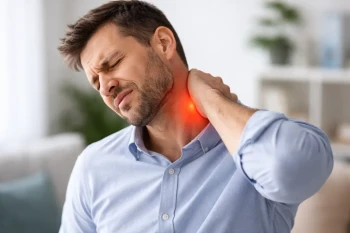
TMJ pain is a general term that covers several conditions of the muscles, joints, and nerves in your lower jaw and face. The full name of the condition is temporomandibular disorder, and the most frequent issue patients have is the inflammation of the TM joint. This is the joint that connects the mandible (the lower jaw) to the upper jaw. It is estimated that nearly 12% of all Americans suffer from this condition during their lifetime. In this article, we will explain why chiropractic adjustments for TMJ pain are the best solution for you.
What Causes TMJ Pain?
The inflammation of the TM joint can be caused by a variety of reasons, such as:
• Excessive chewing
• Frequent clenching or grinding of the teeth
• Injury to the joint
• Poorly fitting orthodontics
• Degenerative joint disease.
In general, TMJ pain is a chronic condition, caused by the overuse of the temporomandibular joint. Habitually chewing gum during the day is one of the biggest factors that can contribute to developing this condition.
By downloading the Digital Patient Chart mobile app you can better control your patient portal.
The Most Common Symptoms of TMJ
We speak of TMJ pain because it is one of the most common symptoms of temporomandibular disorder. However, patients can also experience:
• A popping sound of the jaw when opening and closing their mouth
• Jaw stiffness
• Tinnitus
• Ear pain
• Sensitive teeth in the absence of dental problems
• Headaches.
These symptoms will not go away by themselves and make the most basic human activities, such as eating and speaking, extremely painful.
How Can Chiropractic Adjustments for TMJ Pain Help?
Many people live with TMJ pain for months before they hear of the benefits of chiropractic adjustments. The patients we usually see have gone through several types of painkillers, obtaining only temporary relief. Chiropractic adjustments are not meant to dull the pain. TMJ pain is caused by the fact that something is not right in the alignment of your upper and lower jaws. The chiropractor aims to heal TMJ pain by:
1. Reducing Inflammation
Inflammation of the TM joint can cause pain and reduced mobility in the lower jaw. Chiropractic adjustments for TMJ pain aim to improve blood flow to the affected body part. This helps reduce inflammation, causing pain to recede and restoring the patient’s full mobility of the mandible.
2. Helping the Joint Relax
The tension of the TM joint can be a cause of pain, especially if the patient is frequently clenching and grinding the teeth. Through low-impact and high-vibration adjustments, the chiropractor helps the joint and facial muscles around it relax.
3. Realigning the Jaw
If the main symptom of TMJ is a popping sound when opening the mouth, most probably the patient has a misaligned jaw. Chiropractic adjustments for TMJ pain aim to solve this core issue. There is nothing brusque and painful in the way the chiropractor will guide the lower jaw back to its natural position. Any professional will always pay attention to the patient’s reactions to the manipulation. Whenever the patient shows signs of pain or discomfort, the chiropractor will stop and adjust the pressure or type of manipulation.
4. Encouraging the Patient to Stop Overusing the TM Joint
Finally, once the chiropractic adjustments for TMJ pain solve the issue, the practitioner will talk to the patient about the reason why they developed this condition. If there is no change in the patient’s habits, TMJ pain may return at a later date. Patients are encouraged to find distractions from the tics that cause TM inflammation, such as excessive gum chewing and teeth grinding. This takes time, especially if they are old, ingrained habits. However, with the chiropractor’s friendly and professional assistance, these habits can be corrected.
If you suffer from TMJ pain, we encourage you to reach out to us and schedule an initial appointment. You will receive a personalized treatment plan and soon you will say goodbye to jaw pain and stiffness.







Leave a comment